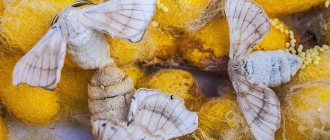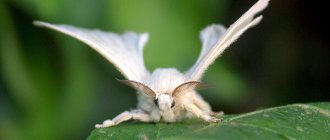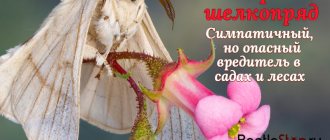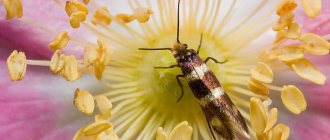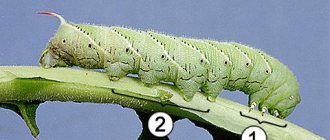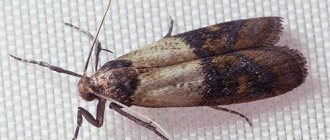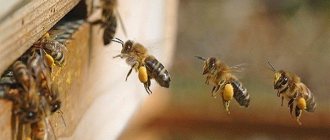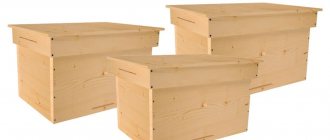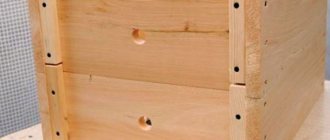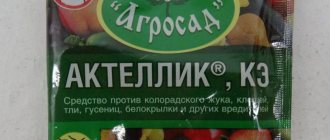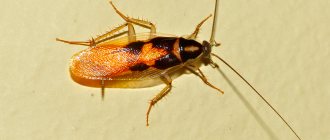Description
The wild silkworm is a butterfly from the True Silkworm family. Today this species is endangered. The silkworm is one of the few domesticated winged insects. In its development it goes through 4 stages. It all starts with laying eggs. From them emerge larvae - mulberry worms. Over time, they pupate, turning into a butterfly.
The insect gained its fame thanks to its unique ability to weave cocoons, which people use as raw materials to produce real silk.
Useful properties of silk thread
Silkworm saliva contains sericin, a substance that protects silk from pests such as moths and mites. The caterpillar secretes matting substances of sheer origin (silk glue) from which it weaves a silk thread. Despite the fact that most of this substance is lost during the production of silk fabric, even the little that remains in the silk fibers can protect the fabric from the appearance of dust mites.
Thanks to serecin, silk has hypoallergenic properties. Due to its elasticity and incredible strength, silk thread is used in surgery for suturing. Silk is used in aviation; parachutes and balloon shells are sewn from silk fabric.
Appearance
In appearance, the wild silkworm resembles an ordinary butterfly with fragile wings. The antennae are comb-like. The wingspan varies between 25-37 mm. They have a light brown color. Often it has a pattern in the form of dark transverse stripes and lines. There is a pronounced discal spot.
The front wings have a small depression on the outer edge. Next to it there is a pronounced moon-like spot of a brown hue.
The hind wings are dark brown. The posterior margin is narrowly darkened. On the underside of the wings, the pattern is represented by external bands and lunate spots on the front wings.
Where does it live?
The wild silkworm has a fairly wide habitat. It can be found in the Far East. From the southern reaches of the Korean Peninsula, including China and Taiwan, to the south of Primorsky Krai.
For reference: You can see wild silkworms in the place where the cultivated shrubby form of mulberry grows. It is a food plant for the caterpillars of this insect.
The flight of butterflies begins in June-September. They are not prone to migration.
Silkworm caterpillar
What does it eat?
Only the silkworm caterpillar feeds. Her diet consists only of mulberry leaves. In captivity, larvae can eat lettuce leaves, milk trees, and ficus trees. However, improper nutrition can harm the health of the caterpillar, which will negatively affect the quality of the cocoon.
For reference: Today there is no universal food for wild silkworms. Scientists are trying to find a replacement for mulberry leaves to diversify the insect's diet. They suggest the scorzonera plant as a good alternative.
Development of the silkworm
Dietary features and lifestyle
At different stages of the life cycle, nutrition and lifestyle vary. Butterflies have a very short period of existence, depending on the breed, lasting from 4-6 to 10-12 and 20-25 days. Females are inactive and do not feed. During silk production, they do not leave the cocoon and die in it. Males are more mobile than females; after fertilization, they stop their life cycle.
Caterpillars have a well-differentiated internal structure. Their digestive system consists of powerful jaws, pharynx, esophagus, crop and intestines. This allows a large amount of mulberry leaves to be absorbed. There is a circulatory and excretory system, oxygen transport is carried out by the respiratory system. The latter is of particular interest: on the sides of the body there are 9 respiratory openings (spiracles), from which branch the trachea, which are divided into small tracheoles, ending in all organs of the larva.
The caterpillars hatched from eggs are very small, the weight of one individual does not exceed 0.005 g. Their distinctive feature is appetite and non-stop feeding, rapid weight gain.
The pupal stage lasts 12-18 days. The organism inside the cocoon is immobilized, no nutrition is provided.
Interesting Facts
The insect itself is quite interesting and unusual. It has been actively studied by scientists all over the world for more than 500 years. This allowed them to uncover several interesting facts:
- The dead pupae remaining after unwinding the silk thread are quite valuable in their nutritional properties as a food product.
- The main enemies of the silkworm are parasitic insects: hedge flies or tahini. The female hedgehog lays eggs on the body or inside the silkworm. As a result, the larvae develop in the body of the silkworm, which leads to its rapid death.
- Silkworm thread is a protein product that can dissolve under the influence of aggressive chemical cleaning agents.
- The female can live only 12 days without making a single flap of her wings.
- Caterpillars are included in the list of medicines. They are infected with a special type of fungus and dried.
Currently, the number of wild silkworms has reached a critical level. This is due to a sharp reduction in the number of places where their food plant grows. Based on this, it is planned to create a protected area for silkworms, as well as their breeding in nurseries.
Mua... mua......!
I recently bought silk scarves for my collection, made by Uzbek craftsmen using the ancient ICAT technique. The technique is incredibly labor-intensive, because it is manual... everything is done by hand, starting from cutting mulberry branches to feed the silkworm caterpillars...
The photo of watermelons is not related to silkworms, but it is relevant to the further discussion. All photos have captions if something is not clear.
Woman selling watermelons at the bazaar in Andijan, Uzbekistan
But at the beginning of the conversation I will show you my purchases. It’s not that I’m bragging... now such things are available for purchase via the Internet and cost quite reasonable money, considering the labor-intensive processes - so almost for nothing, I think. Rather, I admire these products and it’s a pleasure to simply own them. I am glad that I have them, like small grains of the world of my childhood, particles of my Motherland... I wrote earlier that I was born in Central Asia and from birth I saw this colorful world. We went to the market, and there they sold fabrics, and there were mountains of watermelons and melons, spices, ripe tomatoes, and apples and cherries grew on the trees just like that... A strange world...
This is how they sell onions at the bazaar in Fergana, and throughout Central Asia
So, shopping. Two scarves, blue-yellow and red-green. , length about 170 cm, width 49 cm. Scarves are so narrow because they are woven by hand on narrow looms. In Uzbekistan, it is customary that all ikat (fabric made using the ICAT technique, also called “Uzbek pattern”, pictured below) are woven narrow, because this width is convenient for handwork.
Silk scarf ikat shoyi, Uzbekistan
My second silk scarf ikat shoyi, Uzbekistan
My silk scarf ikat shoyi, Uzbekistan
My silk scarf ikat shoyi, Uzbekistan
These scarves are made from 100% natural silk. This can be checked in this way: set fire to a small piece of material, it is enough to set fire to even 1 thread, which is what I did.
checking the quality of silk by burning the thread
Natural silk, when burned, quickly forms a black lump, and this lump smells like burnt horn or feather (which is chemically the same thing, keratin), which easily rubs in your hands (see photo) into dust.
checking the quality of silk by burning the thread
The unnatural material will melt and there will be a lump at the end of the burnt thread…. how to put it more precisely... like lava, such a clot... and it does not rub into dust with your fingers. Viscose, when burned, smells like burnt paper (paper, in fact, it is, since it is made from cellulose), and polyester, which is generally synthetic, will melt and burn without a residue.
Two scarves, blue-yellow and red-green... the threads are dyed with natural dyes, but I will talk about the ikat production technology in the next article, and now a little about silk production in general.
Silk is chemically a protein (protein), so they are called: “silk proteins” and are a long-long chain polymer, more precisely, a “bundle” of these polymers. This polymer (which is silk) is produced internally (like a microfactory!) and released from itself by the silkworm caterpillar at a certain age. These silkworms were domesticated in China 5,000 years ago, but what does "domesticated" mean? In this case, this means that they are selected to obtain a better product, mated with the right person (although females can lay eggs without mating) to increase the size of the cocoon and the thickness and length of the thread in it, its growth rate and efficiency ( cocoon) digestion, their (caterpillars) resistance to disease. In the same way, tolerance for human presence and living “on top of each other” was changed (see photo below, this does not happen in nature). All these modifications have made the domestic silkworm completely dependent on humans... for its survival
Silkworm breeding in Thailand, final stage, cocoons before boiling
The silkworm, like the Drosophila fly, reproduces and grows quickly, so it is easy to track various gene modifications on it. I read the following phrase: “The silkworm is one of the most genetically exploited animals.” Over the 5000 years of domesticated existence, the silk productivity of silkworm varieties has increased almost tenfold relative to its wild ancestors (only corn is ahead of the silkworm in this parameter...). Scientists are also trying to genetically influence the duration of various stages of life of silkworm larvae and caterpillars, and health, productivity, quality of silk, resistance to various pathogens... a lot of different things depend on them, in turn.
Silkworm cocoons at a silk factory. Looks like it's China.
I will briefly describe the process of obtaining silk.
In the summer, silkworm butterflies (after mating with a male silkworm) lay eggs: these eggs are called "grena". This grain is placed in the refrigerator until spring, that is, until the new season. The next spring, with a gradual artificial increase in temperature from 18 to 25 degrees and a certain humidity, the grena awakens, it is checked for the presence of diseased and defective (I don’t know how they do this, apparently from the color of the masonry... something came to mind), then from grenas hatch into 2 mm worms (silkworm larvae). These worms eat crushed mulberry leaves day and night, devour them and grow, devour and grow (and within a month increase in size up to 3-4 cm)... This time of growth and weight gain is quite difficult for the maintenance staff of the greenage factory (so are called factories where silkworm caterpillars are raised from their eggs. Such a factory was in the city of Osh, where I was born): the caterpillars are in large trays with mulberry leaves and are very sensitive to sounds, smells, changes in temperature, humidity, pressure (these caterpillars are not simple, but domesticated already in ancient times and varietal, highly productive, not the same as in simple nature. Well, like a wild orange and a cultivated one... I wrote about this above).
pallets with silkworm caterpillars and crushed mulberry leaves
If you don’t follow the rules, the caterpillar will simply die and all your work will be in vain...
Silkworm caterpillars molt 4 times during growth (they also grow and their skin becomes small for them), while their appetite grows almost exponentially.. The color and appearance of the caterpillars changes greatly from molt to molt, in the bottom photo these are white caterpillars with a horn, judging by the description, are in the 5th instar stage (shortly before pupation).
Silkworm caterpillars eat mulberry leaves
There are so many caterpillars and they eat the leaves so loudly that you can hear it... And then the time comes for metamorphosis into a pupa... the skin of the caterpillars becomes stronger and yellower and silkworm breeders transfer these caterpillars to special branches or nets (like the one in the photo), to which the caterpillars attach and begin to form a silk cocoon.
Formed silkworm cocoons
To form a cocoon, the caterpillars begin to secrete a certain substance from special glands that hardens in air. This substance is a mixture of the protein fibroin and sericin (and some other little things), it’s called “raw silk”, it is thread-like and the caterpillar wraps it around itself, forming a cocoon around itself. First, the caterpillar forms an outer fluff (see in the photo, it’s shaggy), and then inside this fluff wraps the main mass of silk thread around itself.
Traditional Thai mulberry silk - from these yellow cocoons that are produced by the silkworm Bombix Mori
These cocoons are urgently collected and transported to silk-spinning factories in order to catch the moment of metamorphosis of the pupa into a butterfly... the fact is that when the pupa in the cocoon turns into a butterfly (the butterfly does not have a mouthpart), it secretes a proteolytic enzyme (an enzyme that destroys the silk shell of the cocoon , called protease) to get out and fly away to mate. But the cocoon is a CONTINUOUS long thread of silk (from 300 to 900 meters), which the butterfly has wound around itself, and if you pierce the cocoon, you will not get a continuous thread, but short stubs... These stubs are also used, but it will not be high-quality silk thread, it will be a completely different product...
So, the cocoons are taken to a silk spinning factory to extract silk from them. Now, instead of a large factory, there are small handicraft workshops, but this has not changed the essence of the process, and the quality of the products remains excellent.
This is how silk cocoons are steamed and unwoven into threads, Margilan, Uzbekistan
First, the cocoons are sorted by size and color. Then, in order to kill the under-butterfly inside the cocoon, these cocoons are steamed in hot water (boiled, in short). The cocoons swell, part of the silk protein mixture from which the caterpillar made the cocoon dissolves in water (this is the substance I wrote about it above; the caterpillar does not secrete pure silk proteins, but a mixture of different proteins; some of them are actually silk proteins (fibroin) , and others are like glue for gluing silk threads together to form a cocoon (sericin + resins and something else), the cocoon itself feels dense to the touch, like thin felt...). So this kind of glue dissolves in water, releasing the silk threads. Now we need to unwind the cocoons, but it’s not easy.
Silkworm cocoons in hand, Margilan, Uzbekistan. They begin to unwind the cocoons on threads
In large silk-spinning factories, the process of unwinding cocoons is mechanized, but in small farms it is done manually... I won’t say exactly how, but they grab the threads (look at the photo) and begin to pull them, essentially unwinding the cocoons... What follows is the subtleties of the process: a thread of raw silk is formed from 3-10 threads from cocoons, if one of the threads breaks or ends, then a new thread is attached, simply glued: the remains of adhesive sericin are what connect all the tiny threads together. But I’d better say that boiled silkworm pupae (from cocoons) are often used for food. The photo shows cocoons and their contents, that is, silkworm pupae
White cocoons and silkworm pupae. Boiled dolls are eaten in Korea
In South Korea, for example, they are a delicacy (I myself saw how they are sold on the streets and eaten, brrrrr.. this popular snack is called 번데기 or Beondegi, in my opinion they have such a characteristic and disgusting smell...)
Silkworm snack boiled silkworm pupae
Raw silk (which is pulled from the cocoons) is wound into skeins. In the left corner of the photo you can see a skein (a bunch hanging on a stick) of silk, and the thread is wound on a “drum”.
Reeling and spinning silk, Margilan, Uzbekistan
And below in the photo a woman is spinning a silk thread (that is, twisting it)
Spinning silk threads, Margilan, Uzbekistan
The silk thread has been spun and there will be a new article about how silk fabric is made using ICAT technology.
Just curious: the life cycle of the silkworm
In writing the article, I used information from my memory, and took some things from the articles of the master Ksenia Semencha and here https://www.suekayton.com/silk.htm, and bought scarves from Anastasia Bulavka. Part of the photo from the site https://www.projectbly.com/, part of https://www.flickr.com/photos/adam_jones/
